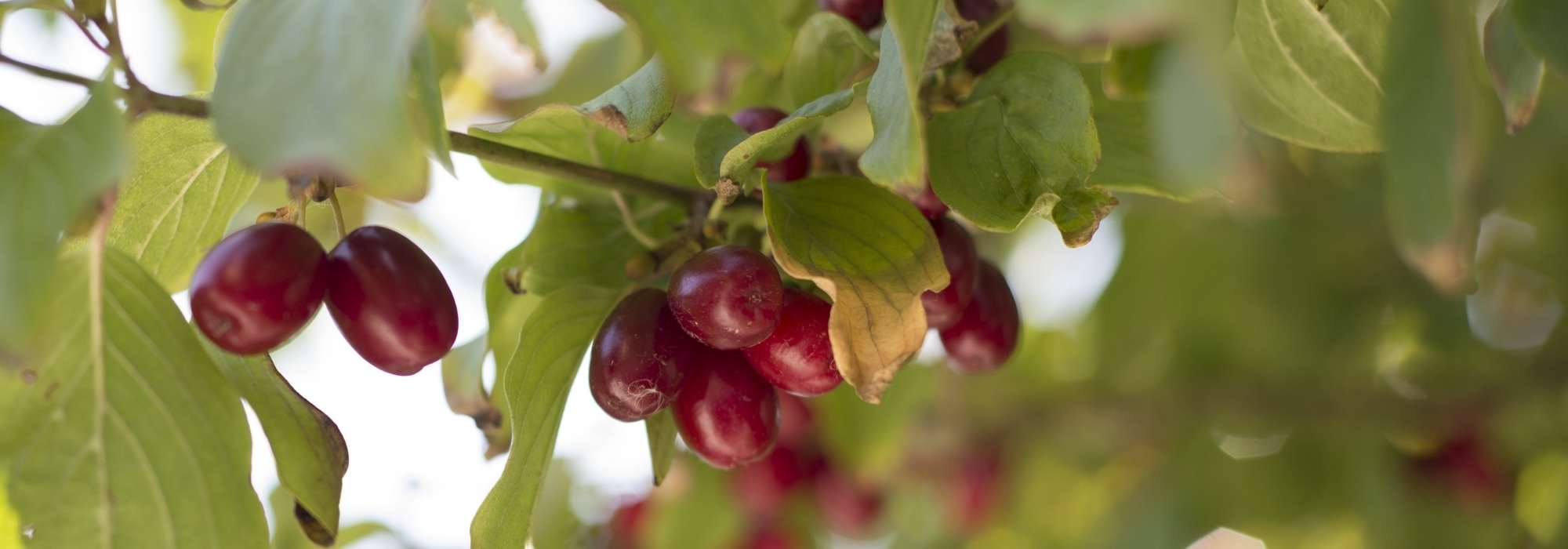
Growing dogwood for its fruits
Cornus mas, an old forgotten fruit tree...
Contents
“Cornouille!” could be an old-fashioned insult. In fact, it is the name of the edible fruit of a native bush: the Cornus mas or Male Cornel. The Male Cornel is gradually making a comeback in our gardens for various reasons: very early yellow flowering that is beneficial to pollinators, beautiful autumn foliage, edible fruits that are useful to wildlife, and ease of cultivation. But did you know that some varieties of Male Cornel are selected to produce larger, more colourful, or tastier fruits? How do you grow Male Cornel and which variety should you choose for good production? Let’s take stock.
The male dogwood in a few words
Cornus mas or male Cornel, sometimes referred to as the “Normandy Olive”, is a small native tree typical of the limestone soils in the northern part of France (especially in the east) and Belgium. It is found elsewhere in the world mainly in Eastern Europe and the Near East. It belongs to the Cornaceae family and shares the same genus, Cornus, with many garden dogwoods: Cornus kousa, Cornus alba, Cornus sanguinea, Cornus controversa…
The leaves are opposite, simple, and exhibit the characteristic nervature of dogwoods. The foliage is deciduous and displays beautiful colours in autumn.
The bright yellow flowering is very early. The small yellow flowers, arranged in simple umbels, bloom during February, before the leaves appear. This is an advantage for the first foragers venturing out early in the season. However, unfortunately, in some years, flowering occurs at a time when few insects are active in the garden, which can hinder potential fruiting.
The fruits, known as dogwood berries, are drupes shaped like small olives and borne on a peduncle. The colour of these drupes ranges from bright red to burgundy depending on the ripeness, which occurs in August. The pulp is naturally acidic but sweetens as the fruit ripens. Fruiting is subject to alternate bearing: good production every two years.
It can be grown either in a free-standing hedge, as a specimen, or in a mass planting and responds well to pruning, although it tends to grow chaotically afterwards. So, keep the pruning shear light! The male Cornel, if left undisturbed, grows to 4 m in all directions at maturity but can reach over 10 m high in the wild over time. The growth is relatively slow. It can live up to 300 years.
Nota bene: Cornel wood was used in antiquity for making tool or weapon handles.
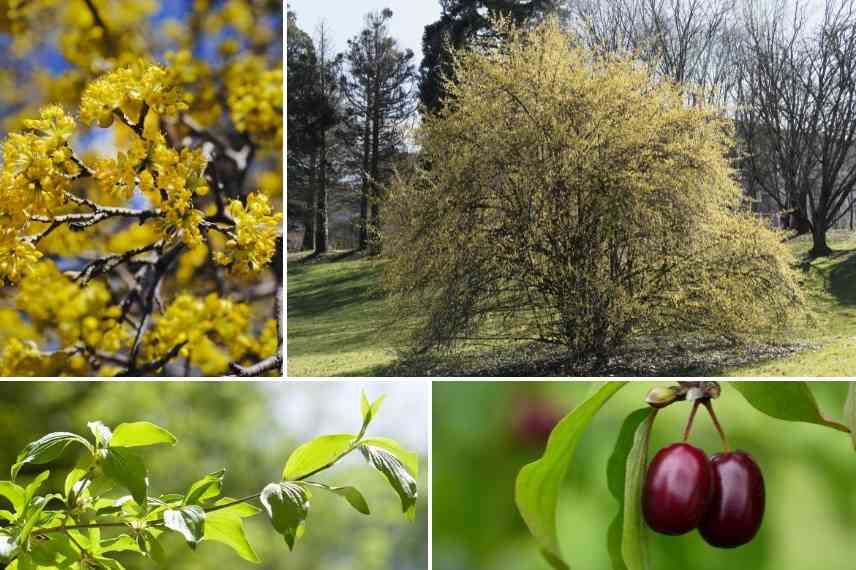
Beauty of Cornus mas in its spring flowering, foliage, habit, and… its fruits!
How to grow the male dogwood?
Exposure
The male dogwood requires sunlight. A partially shaded position is possible, but the tree will flower less well and therefore produce fewer fruits.
Soil
In the wild, the male dogwood prefers calcareous soils but can adapt to a wide range of soils: ordinary, rather light, even poor. The male dogwood thrives in soils with a basic (calcareous), neutral to slightly acidic pH. If your soil is too acidic, consider its Asian cousin: Cornus officinalis (see below).
A soil that remains cool allows for faster growth of the bush. However, the male dogwood can adapt to drier soils. It is particularly resistant to drought once well established.
Well-drained soil prevents issues in winter. If your soil is very clayey and compact, do not neglect to improve drainage at planting by adding clay balls and compost.
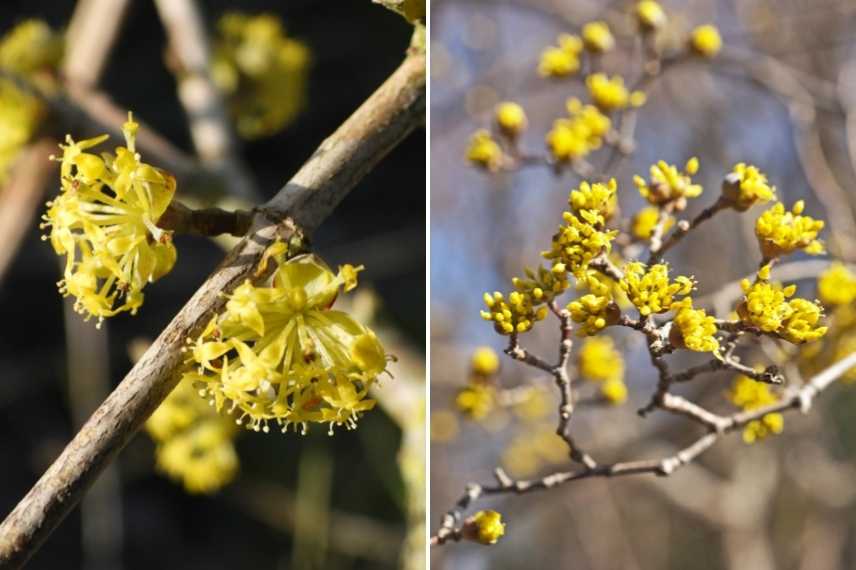
Flowering of Cornus mas and Cornus officinalis
Planting Period
The best planting period is autumn: October-November. However, planting is also possible in late winter, between February and March.
Maintenance Required
The male dogwood is very hardy and does not suffer from any diseases if grown in sufficiently drained soil.
Pruning is not obligatory, of course. However, it can be pruned if desired at the end of winter before the resumption of growth, in February, to remove dead wood or poorly placed branches. A transparent pruning significantly improves its shape and flowering.
Discover other Cornus
View all →Available in 0 sizes
Available in 0 sizes
Available in 2 sizes
Available in 1 sizes
Available in 2 sizes
Available in 1 sizes
Available in 3 sizes
Available in 2 sizes
Available in 2 sizes
Available in 3 sizes
The best fruiting varieties of Cornus mas
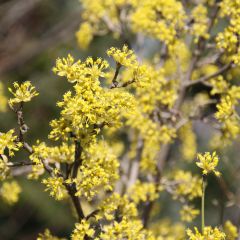
Cornus mas Jolico - European Cornel
- Flowering time March to May
- Height at maturity 3 m
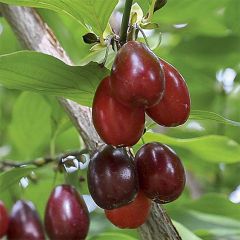
Cornus mas Schönbrunner Gourmet Dirndl - European Cornel
- Flowering time April, May
- Height at maturity 4 m
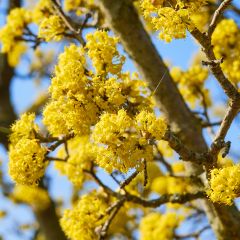
Cornus mas Kasanlak - European Cornel
- Flowering time April, May
- Height at maturity 4,50 m
Among the other male dogwoods selected for their fruit production, we note the variety ‘Matador’, a French production with large red fruits that ripen early, the cultivar ‘Golden Glory’ with its very abundant flowering, and ‘Xanthocarpa’ (synonym ‘Flava’) with yellow fruits (but with the same taste as the red fruits).
The cultivars selected for fruit production are all fairly equal. The differences regarding fruit size and yield are quite minimal. Only the ripening period will prove to be a true selection criterion.
One can also choose a male dogwood for the beauty of its foliage. Thus, there is the Cornus mas ‘Aurea’ with golden yellow foliage, Cornus mas ‘Variegata’ with green foliage variegated with white, or the Cornus mas alba ‘Elegantissima’, which is very low in flowering but has variegated yellow and green foliage with some small touches of pink.
There is a fastigiate form: Cornus mas ‘Pyramidalis’ and a dwarf form: Cornus mas ‘Nana’, not exceeding 1.50 m in height.
When and how to harvest dogwoods?
Dogwoods are gathered once they fall to the ground or picked just before they drop when they are red to burgundy in colour, around August. They should be consumed when fully ripe, as they are acidic, astringent, and laxative when unripe. To recognise the “edible” stage, two things must be considered: the colour should lean towards burgundy and the flesh should be slightly soft to the touch.
The harvest period depends on the cultivar and the year. The fruits of the Cornelian cherry or Cornus officinalis (see below) are harvested later: around October.
Dogwoods are climacteric fruits. This means that the drupes continue to ripen after being picked, like apples and pears, for example. So you can either wait until they are fully ripe but have fallen to the ground, which requires cleaning the fruit, or pick them when the first ones start to drop and keep them in a cool, ventilated place to allow them to continue ripening.
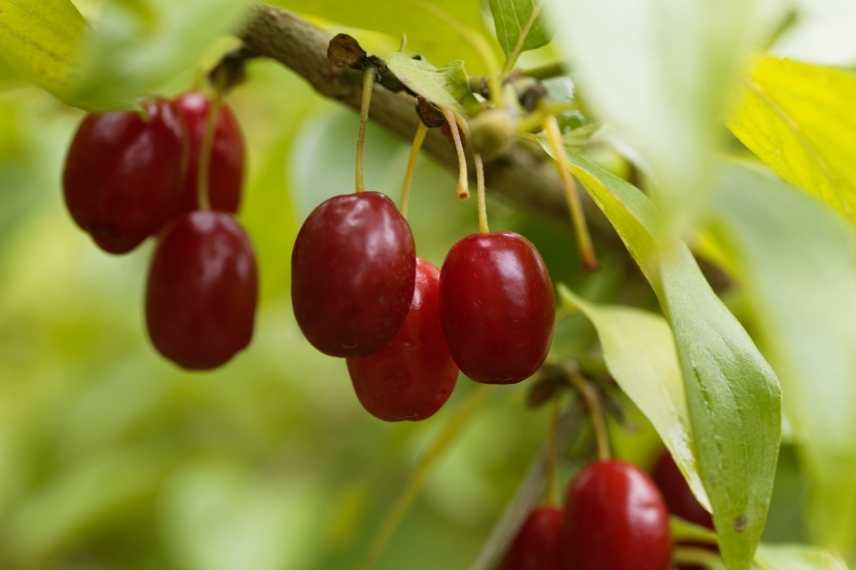 The fruits of the dogwood are harvested when they are a beautiful burgundy red
The fruits of the dogwood are harvested when they are a beautiful burgundy red
What to do with dogwoods?
Dogwoods can be consumed raw or prepared as jellies, jams, compotes, in tarts, or for the distillation of liqueurs.
In Armenia, a dogwood wine is produced from fermented fruits.
Please note: dogwoods are said to be naturally rich in vitamin C and anthocyanins.
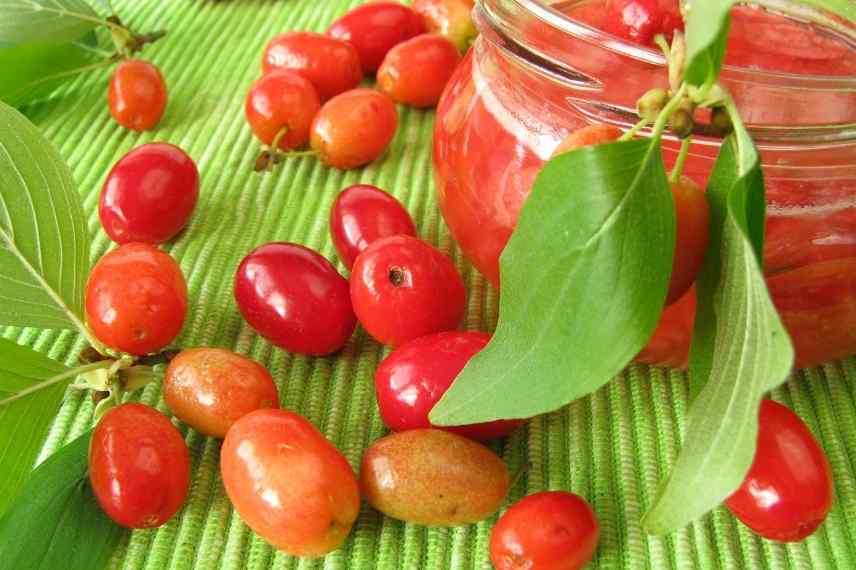
Dogwood jam
And what about the other dogwoods?
There is an Asian cousin of the male dogwood: the Cornus officinalis or Cornelian cherry. This bush or small tree is larger and more vigorous than the male dogwood (up to 6 m tall), producing larger flowers and fruits. It even tends to produce more drupes than its European counterpart. The Cornus chinensis or Chinese dogwood (not to be confused with Cornus kousa var. chinensis) resembles Cornus officinalis, but is almost impossible to find at nurseries. In any case, its black drupes are far less palatable than those of the male dogwood or the Cornelian cherry.
The fruits of Cornus kousa are, in theory, edible. In practice, they are bland and of little interest. The cultivar ‘Christine’ does produce large fruits that are almost tasty.
The fruits of other dogwoods should be avoided!
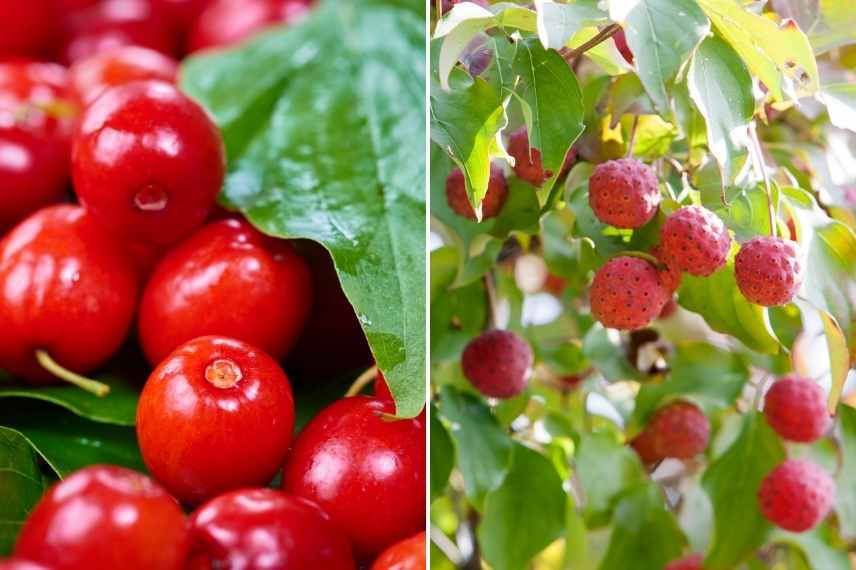
Do not confuse the drupes of Cornus mas with the recognisable fruits of Cornus kousa
My dogwood tree hardly bears any fruit. What is happening?
If it is very young, that is normal. The Cornus mas needs 5 to 6 years to bear fruit well.
Otherwise, it is because it is solitary. Indeed, the male dogwood can, in theory, produce drupes on its own. However, it will only produce a few fruits per year this way. To achieve a significant yield, this tree needs one or more companions nearby to benefit from cross-pollination. For example, you can plant a Cornus mas of a fruit-bearing variety (a ‘Jolico’ for instance) and plant one or two male dogwoods of the species type in a natural hedge a few dozen metres away from it.
- Subscribe!
- Contents
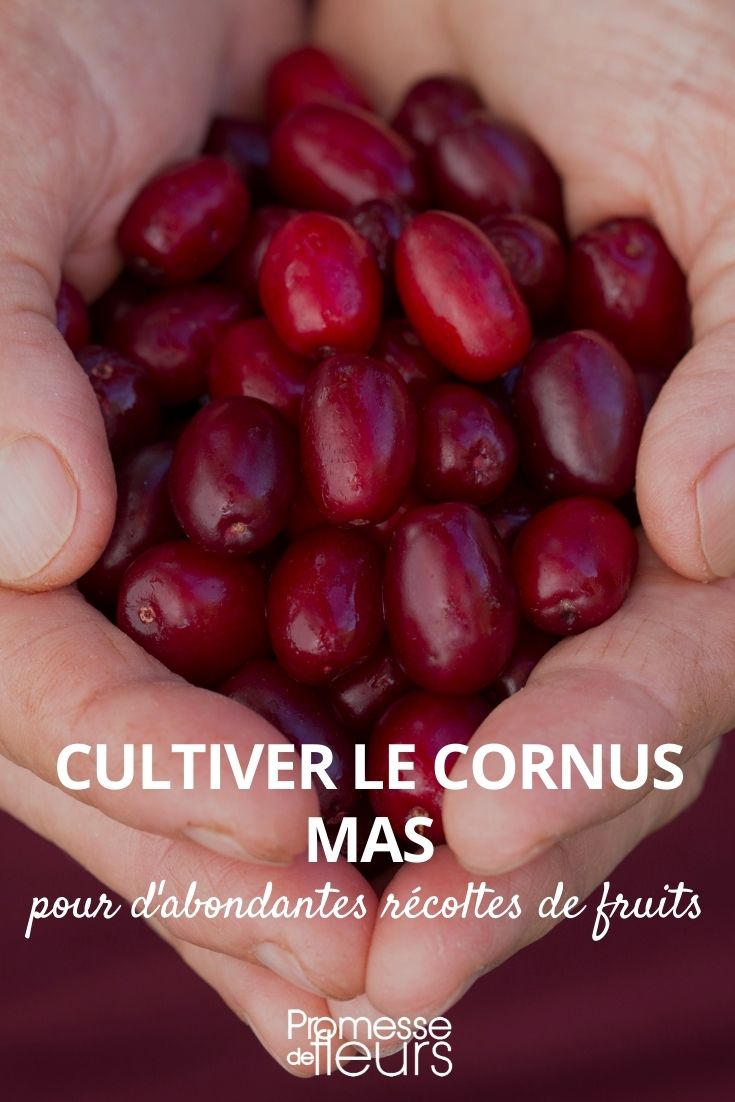































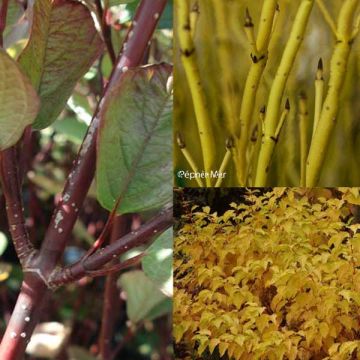
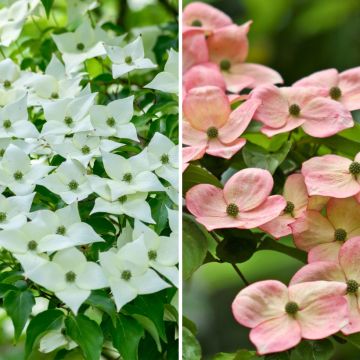
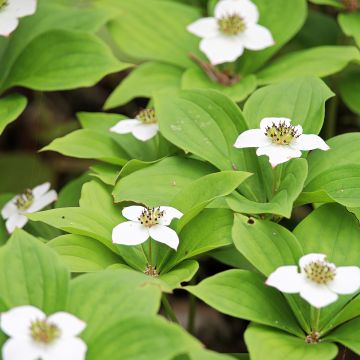
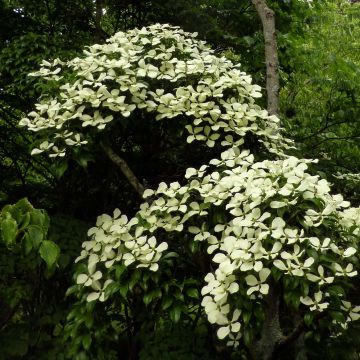

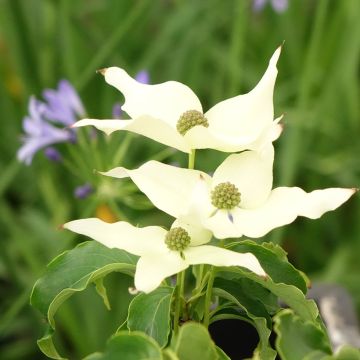


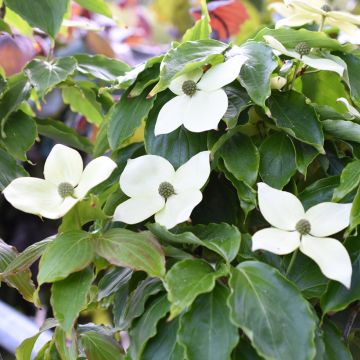
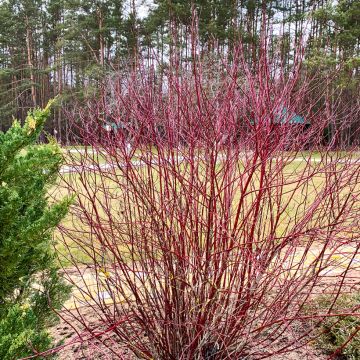
Comments